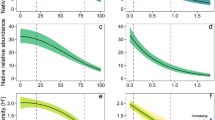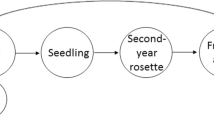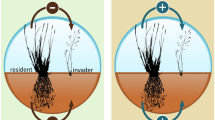Abstract
The theoretical foundations of population and community ecology stress the importance of identifying crucial niche requirements and life history stages of invasive species and, in doing so, give insight into research and management. We focus on Microstegium vimineum, an invasive grass which is causing marked changes in the structure and function of US forests. We describe M. vimineum’s life history and habitat characteristics, infer its niche requirements and synthesize this information in the context of population dynamics and management. Based on the results synthesized here, M. vimineum’s crucial niche requirements appear to be light (reproductive output), soil moisture (reproductive output, seedling recruitment) and aboveground coverage by leaf-litter and competing species (seedling recruitment and survival). These data suggest a source-sink dynamic might allow M. vimineum to disperse and thrive along sunny, and sometimes wet, edge habitats and, in turn, these populations might act as source populations for adjacent shady forest habitats. By evaluating M. vimineum in the context of its stage-specific requirements, we highlight potential weaknesses in its life history that provide strategies for effective management.
Similar content being viewed by others
References
Adams SN, Engelhardt KAM (2009) Diversity declines in Microstegium vimineum (Japanese stiltgrass) patches. Biol Conserv 142:1003–1010
Albrecht MA, McCarthy BC (2009) Seedling establishment shapes the distribution of shade-adapted forest herbs across a topographical moisture gradient. J Ecol 97:1037–1049
Austin MP (2002) Spatial prediction of species distribution: an interface between ecological theory and statistical modelling. Ecol Model 157:101–118
Baiser B, Lockwood JL, La Puma D, Aronson MFJ (2008) A perfect storm: two ecosystem engineers interact to degrade deciduous forests of New Jersey. Biol Invasions 10:785–795
Barden LS (1987) Invasion of Microstegium vimineum (Poaceae), an exotic, annual, shade-tolerant, C-4 grass, into a North-Carolina floodplain. Am Midl Nat 118:40–45
Barden LS (1996) The linear relation between stand yield and integrated light in a shade-adapted annual grass. Bull Torrey Bot Club 123:122–125
Belote RT, Jones RH (2009) Tree leaf litter composition and nonnative earthworms influence plant invasion in experimental forest floor mesocosms. Biol Invasions 11:1045–1052
Belote RT, Weltzin JF (2006) Interactions between two co-dominant, invasive plants in the understory of a temperate deciduous forest. Biol Invasions 8:1629–1641
Bohlen PJ, Groffman PM, Fahey TJ, Fisk MC, Suarez E, Pelletier DM, Fahey RT (2004a) Ecosystem consequences of exotic earthworm invasion of north temperate forests. Ecosystems 7:1–12
Bohlen PJ, Pelletier DM, Groffman PM, Fahey TJ, Fisk MC (2004b) Influence of earthworm invasion on redistribution and retention of soil carbon and nitrogen in northern temperate forests. Ecosystems 7:13–27
Boyd N, Van Acker R (2004) Seed germination of common weed species as affected by oxygen concentration, light, and osmotic potential. Weed Sci 52:589–596
Bradford MA, Schumacher HB, Catovsky S, Eggers T, Newington JE, Tordoff GM (2007) Impacts of invasive plant species on riparian plant assemblages: interactions with elevated atmospheric carbon dioxide and nitrogen deposition. Oecologia 152:791–803
Bradford MA, DeVore JL, Maerz JC, McHugh JV, Smith CL, Strickland MS (2010) Native, insect herbivore communities derive a significant proportion of their carbon from a widespread invader of forest understories. Biol Invasions 12:1464–1573
Bruno JF, Stachowicz JJ, Bertness MD (2003) Inclusion of facilitation into ecological theory. Trends Ecol Evol 18:119–125
Cain ML (1994) Consequences of foraging in clonal plant-species. Ecology 75:933–944
Campbell CS, Quinn JA, Cheplick GP, Bell TJ (1983) Cleistogamy in grasses. Annu Rev Ecol Syst 14:411–441
Carreiro MM, Sinsabaugh RL, Repert DA, Parkhurst DF (2000) Microbial enzyme shifts explain litter decay responses to simulated nitrogen deposition. Ecology 81:2359–2365
Carson WP, Peterson CJ (1990) The role of litter in an old-field community—impact of litter quantity in different seasons on plant-species richness and abundance. Oecologia 85:8–13
Casper BB, Castelli JP (2007) Evaluating plant-soil feedback together with competition in a serpentine grassland. Ecol Lett 10:394–400
Chase JM, Leibold MA (2003) Ecological niches: linking classical and contemporary approaches. University of Chicago, Chicago, p 180
Cheplick GP (1998) Seed dispersal and seedling establishment in grass populations. In: Cheplick GP (ed) Population biology of grasses. Cambridge University Press, Cambridge, pp 84–105
Cheplick GP (2005) Biomass partitioning and reproductive allocation in the invasive, cleistogamous grass Microstegium vimineum: Influence of the light environment. J Torrey Bot Soc 132:214–224
Cheplick GP (2006) A modular approach to biomass allocation in an invasive annual (Microstegium vimineum; Poaceae). Am J Bot 93:539–545
Cheplick GP (2007) Plasticity of chasmogamous and cleistogamous reproductive allocation in grasses. Aliso 23:286–294
Cheplick GP (2008) Growth trajectories and size-dependent reproduction in the highly invasive grass Microstegium vimineum. Biol Invasions 10:761–770
Cheplick GP (2010) Limits to local spatial spread in a highly invasive annual grass (Microstegium vimineum). Biol Invasions (Online First). doi:10.1007/s10530-009-9587-0
Christen DC, Matlack GR (2009) The habitat and conduit functions of roads in the spread of three invasive plant species. Biol Invasions 11:453–465
Civitello DJ, Flory SL, Clay K (2008) Exotic grass invasion reduces survival of Amblyomma americanum and Dermacentor variabilis ticks (Acari: Ixodidae). J Med Entomol 45:867–872
Claridge K, Franklin SB (2002) Compensation and plasticity in an invasive plant species. Biol Invasions 4:339–347
Cole PG, Weltzin JF (2004) Environmental correlates of the distribution and abundance of Microstegium vimineum, in east Tennessee. Southeast Nat 3:545–562
Cole PG, Weltzin JF (2005) Light limitation creates patchy distribution of an invasive grass in eastern deciduous forests. Biol Invasions 7:477–488
Crooks JA (2002) Characterizing ecosystem-level consequences of biological invasions: the role of ecosystem engineers. Oikos 97:153–166
D’Antonio CM, Chambers JC (2006) Using ecological theory to manage or restore ecosystems affected by invasive plant species. In: Falk DA, Palmer MA, Zedler JB (eds) Foundations of restoration ecology. Island Press, Washington
D’Antonio CM, Vitousek PM (1992) Biological invasions by exotic grasses. Annu Rev Ecol Syst 23:63–87
D’Antonio CM, Hughes RF, Mack M, Hitchcock D, Vitousek PM (1998) The response of native species to removal of invasive exotic grasses in a seasonally dry Hawaiian woodland. J Veg Sci 9:699–712
DeMeester JE (2009) Feedbacks of nitrogen cycling and invasion with the non-native plant, Microstegium vimineum, in riparian wetlands. Department of the Environment, Duke University, Durham
DeMeester JE, Richter D (2009) Restoring restoration: removal of the invasive plant Microstegium vimineum from a North Carolina wetland. Biol Invasions (Online First)
Donovan LA, Mausberg J, Ehleringer JR (1993) Seedling size and survival for Chrysothamnus-Nauseosus. Great Basin Nat 53:237–245
Droste T, Flory SL, Clay K (2010) Variation for phenotypic plasticity among populations of an invasive exotic grass. Plant Ecol (Online First). doi:10.1007/s11258-009-9673-5
Dukes JS, Mooney HA (1999) Does global change increase the success of biological invaders? Trends Ecol Evol 14:135–139
Dyer AR, Rice KJ (1999) Effects of competition on resource availability and growth of a California bunchgrass. Ecology 80:2697–2710
Ehrenfeld JG, Kourtev P, Huang WZ (2001) Changes in soil functions following invasions of exotic understory plants in deciduous forests. Ecol Appl 11:1287–1300
Elton CS (1958) The ecology of invasions of animals and plants. Methuen, London
Eschtruth AK, Battles JJ (2009) Acceleration of exotic plant invasion in a forested ecosystem by a generalist herbivore. Conserv Biol 23:388–399
Evans JR, Poorter H (2001) Photosynthetic acclimation of plants to growth irradiance: the relative importance of specific leaf area and nitrogen partitioning in maximizing carbon gain. Plant Cell Environ 24:755–767
Evans CW, Moorhead DJ, Bargeron CT, Douce GK (2006) Invasive plant responses to silvicultural practices in the south. The University of Georgia Bugwood Network, 52 pp
Fairbrothers DE, Gray JR (1972) Microstegium-Vimineum (Trin) a-Camus (Gramineae) in United-States. Bull Torrey Bot Club 99:97
Flory SL (2010) Management of Microstegium vimineum invasions and recovery of resident plant communities. Restor Ecol 18:103–112
Flory SL, Clay K (2009a) Invasive plant removal method determines native plant community responses. J Appl Ecol 46:434–442
Flory SL, Clay K (2009b) Non-native grass invasion alters native plant composition in experimental communities. Biol Invasions (Online First). doi:10.1007/s10530-009-9546-9
Flory SL, Rudgers JA, Clay K (2007) Experimental light treatments affect invasion success and the impact of Microstegium vimineum on the resident community. Nat Areas J 27:124–132
Foster BL, Gross KL (1998) Species richness in a successional grassland: effects of nitrogen enrichment and plant litter. Ecology 79:2593–2602
Gallagher RS, Fuerst EP (2006) The ecophysiological basis of weed seed longevity in the soil. In: Basra A (ed) Handbook of seed science and technology. Haworth Press, Inc., Binghamton, NY, USA
George LO, Bazzaz FA (1999a) The fern understory as an ecological filter: emergence and establishment of canopy-tree seedlings. Ecology 80:833–845
George LO, Bazzaz FA (1999b) The fern understory as an ecological filter: growth and survival of canopy-tree seedlings. Ecology 80:846–856
Gibson DJ, Spyreas G, Benedict J (2002) Life history of Microstegium vimineum (Poaceae), an invasive grass in southern Illinois. J Torrey Bot Soc 129:207–219
Gilliam FS, Turrill NL (1993) Herbaceous layer cover and biomass in a young versus a mature stand of a central Appalachian hardwood forest. Bull Torrey Bot Club 120:445–450
Glasgow LS, Matlack GR (2007) The effects of prescribed burning and canopy openness on establishment of two non-native plant species in a deciduous forest, southeast Ohio, USA. For Ecol Manag 238:319–329
Grinnell J (1917) The niche-relationships of the California Thrasher. Auk 34:427–433
Guisan A, Zimmermann NE (2000) Predictive habitat distribution modeling in ecology. Ecol Model 135:147–186
Hogan DM, Walbridge MR (2009) Recent land cover history and nutrient retention in riparian wetlands. Environ Manag (Online First). doi:10.1007/s00267-009-9313-9
Horton JL, Neufeld HS (1998) Photosynthetic responses of Microstegium vimineum (Trin.) A. Camus, a shade-tolerant, C-4 grass, to variable light environments. Oecologia 114:11–19
Howard JL (2005) Microstegium vimineum. Fire Effects Information System, US Department of Agriculture, Forest Service, Rocky Mountain Research Center
Huebner CD (2010a) Establishment of an invasive grass in closed-canopy deciduous forests across local and regional environmental gradients Biol Invasions (Online First). doi:10.1007/s10530-009-9609-y
Huebner CD (2010b) Spread of an invasive grass in closed-canopy deciduous forests across local and regional environmental gradients Biol Invasions (Online First). doi:10.1007/s10530-009-9610-5
Hulme PE (2003) Biological invasions: winning the science battles but losing the conservation war? Oryx 37:178–192
Hunt DM, Zaremba RE (1992) The northeastward spread of Microstegium vimineum (Poaceae) into New York and adjacent states. Rhodora 94:167–170
Hutchinson GE (1957) Population studies—animal ecology and demography—concluding remarks. Cold Spring Harbor Symp Quant Biol 22:415–427
Hutchinson GE (1959) Homage to Santa-Rosalia or why are there so many kinds of animals. Am Nat 93:145–159
Judge CA (2008) Japanese stiltgrass (Microstegium vimineum) management for restoration of native plant communities. Invasive Plant Sci Manag 1:111–119
Judge CA, Neal JC, Derr JF (2005) Response of Japanese stiltgrass (Microstegium vimineum) to application timing, rate, and frequency of postemergence herbicides. Weed Technol 19:912–917
Kearney M (2006) Habitat, environment and niche: what are we modelling? Oikos 115:186–191
Kleczewski NM, Flory SL (2010) Leaf blight disease on the invasive grass Microstegium vimineum caused by a Bipolaris sp. Plant Dis 94:807–811
Knight TM, Dunn JL, Smith LA, Davis J, Kalisz S (2009) Deer facilitate invasive plant success in a Pennsylvania forest understory. Nat Areas J 29:110–116
Kourtev PS, Ehrenfeld JG, Huang WZ (1998) Effects of exotic plant species on soil properties in hardwood forests of New Jersey. Water Air Soil Pollut 105:493–501
Kourtev PS, Ehrenfeld JG, Haggblom M (2002a) Exotic plant species alter the microbial community structure and function in the soil. Ecology 83:3152–3166
Kourtev PS, Ehrenfeld JG, Huang WZ (2002b) Enzyme activities during litter decomposition of two exotic and two native plant species in hardwood forests of New Jersey. Soil Biol Biochem 34:1207–1218
Kourtev PS, Ehrenfeld JG, Haggblom M (2003) Experimental analysis of the effect of exotic and native plant species on the structure and function of soil microbial communities. Soil Biol Biochem 35:895–905
Lambers HF, Chapin SI, Pons TL (1998) Plant physiological ecology. Springer, New York
Leicht SA, Silander JA, Greenwood K (2005) Assessing the competitive ability of Japanese stilt grass, Microstegium vimineum (Trin.) A. Camus. J Torrey Bot Soc 132:573–580
Lockwood JL, Hoopes MF, Marchetti MP (2007) Invasion ecology. Blackwell Publishing, Malden
Malik N, Vandenborn WH (1987) Germination response of Galium-Spurium L to light. Weed Res 27:251–258
Marshall JM, Buckley DS (2008a) Effects of microsites created by selective harvesting on growth of Microstegium vimineum in a central hardwood forest. For Sci 54:534–542
Marshall JM, Buckley DS (2008b) Influence of litter removal and mineral soil disturbance on the spread of an invasive grass in a Central Hardwood forest. Biol Invasions 10:531–538
Marshall JM, Buckley DS, Franklin JF (2009) Competitive interaction between Microstegium vimineum and first-year seedlings of three central hardwoods. J Torrey Bot Soc 136:342–349
Martin PH, Canham CD, Marks PL (2009) Why forests appear resistant to exotic plant invasions: intentional introductions, stand dynamics, and the role of shade tolerance. Front Ecol Environ 7:142–149
McGrath DA, Binkley MA (2009) Microstegium vimineum invasion changes soil chemistry and microarthropod communities in Cumberland Plateau forests. Southeast Nat 8:141–156
Mehrhoff LJ (2000) Perennial Microstegium vimineum (Poaceae): an apparent misidentification? J Torrey Bot Soc 127:251–254
Morrison JA, Lubchansky HA, Mauck KE, McCartney KM, Dunn B (2007) Ecological comparison of two co-invasive species in eastern deciduous forests: Alliaria petiolata and Microstegium vimineum. J Torrey Bot Soc 134:1–17
Mortensen DA, Rauschert ESJ, Nord AN, Jones BP (2009) Forest roads facilitate the spread of invasive plants. Invasive Plant Sci Manag 2:191–199
Neufeld HS, Young DR (2003) Ecophysiology of the herbaceous layer in temperate deciduous forests. In: Gilliam F, Roberts M (eds) The herbaceous layer in forests of Eastern North America. Oxford University Press, Oxford, pp 38–90
NPS (1999) Great Smoky Mountain National Park Management Folio #4. In: Service USNP (ed), p 4
Nuzzo VA, Maerz JC, Blossey B (2009) Earthworm invasion as the driving force behind plant invasion and community change in northeastern North American forests. Conserv Biol 23:966–974
Oswalt CM, Oswalt SN (2007) Winter litter disturbance facilitates the spread of the nonnative invasive grass Microstegium vimineum (Trin.) A. Camus. For Ecol Manag 249:199–203
Oswalt CM, Oswalt SN, Clatterbuck WK (2007) Effects of Microstegium Vimineum (Trin.) A. Camus on native woody species density and diversity in a productive mixed-hardwood forest in Tennessee. For Ecol Manag 242:727–732
Padilla FM, Miranda JD, Pugnaire FI (2007) Early root growth plasticity in seedlings of three Mediterranean woody species. Plant Soil 296:103–113
Paul EA, Clark FE (1996) Soil microbiology and biochemistry. Academic Press, San Diego
Price SC, Jain SK (1981) Are inbreeders better colonizers. Oecologia 49:283–286
Pulliam HR (1988) Sources, sinks, and population regulation. Am Nat 132:652–661
Pulliam HR (2000) On the relationship between niche and distribution. Ecol Lett 3:349–361
Purdy BG, Macdonald SE, Dale MRT (2002) The regeneration niche of white spruce following fire in the mixedwood boreal forest. Silva Fenn 36:289–306
Rauschert ESJ, Mortensen DA, Bjornstad ON, Nord AN, Peskin N (2010) Slow spread of the aggressive invader, Microstegium vimineum (Japanese stiltgrass). Biol Invasions (Online First). doi:10.1007/s10530-009-9463-y
Redman DE (1995) Distribution and habitat types for Nepal Microstegium [Microstegium vimineum (Trin.) Camus] in Maryland and the District of Columbia. Castanea 60:270–275
Reich PB, Walters MB, Ellsworth DS (1997) From tropics to tundra: global convergence in plant functioning. Proc Natl Acad Sci USA 94:13730–13734
Royo AA, Carson WP (2006) On the formation of dense understory layers in forests worldwide: consequences and implications for forest dynamics, biodiversity, and succession. Can J For Res-Revue Canadienne De Recherche Forestiere 36:1345–1362
Schramm JW and Ehrenfeld JG (2010) Leaf litter and understory canopy shade limit the establishment, growth and reproduction of Microstegium vimineum. Biol Invasions (Online First). doi:10.1007/s10530-010-9711-1
Schupp EW (1995) Seed seedling conflicts, habitat choice, and patterns of plant recruitment. Am J Bot 82:399–409
Strickland MS, DeVore JL, Maerz JC, Bradford MA (2009) Grass invasion of a hardwood forest is associated with declines in belowground carbon pools. Glob Chang Biol 16:1338–1350
Strickland MS, DeVore JL, Maerz JC, Bradford MA (2010) Grass invasion of a hardwood forest is associated with declines in belowground carbon pools. Glob Chang Biol 16:1338–1350
Touchette BW and Romanello GA (2010) Growth and water relations in a central North Carolina population of Microstegium vimineum (Trin.) A. Camus. Biol Invasions (Online First). doi:10.1007/s10530-009-9510-8
USDA N (2008) The PLANTS database. Retrieved from http://plants.usda.gov
Vitousek PM (1990) Biological invasions and ecosystem processes—towards an integration of population biology and ecosystem studies. Oikos 57:7–13
Von Holle B, Delcourt HR, Simberloff D (2003) The importance of biological inertia in plant community resistance to invasion. J Veg Sci 14:425–432
Warren R (2010) An experimental test of well-described vegetation patterns across slope aspects using woodland herb transplants and manipulated abiotic drivers. New Phytol 185:1038–1049
Webster CR, Rock JH, Froese RE, Jenkins MA (2008) Drought-herbivory interaction disrupts competitive displacement of native plants by Microstegium vimineum, 10-year results. Oecologia 157:497–508
Whittaker RH (1956) Vegetation of the Great Smoky Mountains. Ecol Monogr 26:1–69
Winter K, Schmitt MR, Edwards GE (1982) Microstegium-Vimineum, a shade adapted C-4 grass. Plant Sci Lett 24:311–318
Wright JP, Jones CG (2006) The concept of organisms as ecosystem engineers ten years on: progress, limitations, and challenges. Bioscience 56:203–209
Wuest SB, Albrecht SL, Skirvin KW (1999) Vapor transport vs. seed-soil contact in wheat germination. Agron J 91:783–787
Xiong SJ, Nilsson C (1999) The effects of plant litter on vegetation: a meta-analysis. J Ecol 87:984–994
Yurkonis KA, Meiners SJ (2006) Drought impacts and recovery are driven by local variation in species turnover. Plant Ecol 184:325–336
Acknowledgments
This review was supported by funds from the National Science Foundation (award DEB-0823293) to the Coweeta Long Term Ecological Research Program and by the Yale School of Forestry and Environmental Studies.
Author information
Authors and Affiliations
Corresponding author
Rights and permissions
About this article
Cite this article
Warren, R.J., Wright, J.P. & Bradford, M.A. The putative niche requirements and landscape dynamics of Microstegium vimineum: an invasive Asian grass. Biol Invasions 13, 471–483 (2011). https://doi.org/10.1007/s10530-010-9842-4
Received:
Accepted:
Published:
Issue Date:
DOI: https://doi.org/10.1007/s10530-010-9842-4




